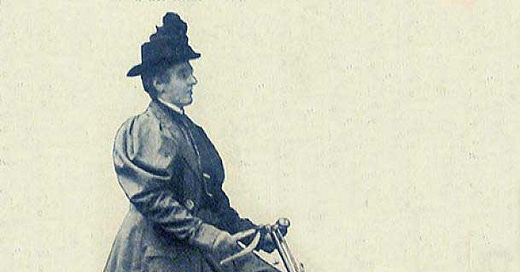This week’s Design Lobster is all about comfort. From the surprisingly controversial story of knickerbockers to an ingenious type of Japanese table.
Also, a special welcome this week to the new readers who found me via Soren Iverson’s newsletter – it’s great to have you here👋
✨Enjoying Design Lobster? Please share it with a friend, colleague or fellow designer.
Question: Why were knickerbockers so controversial?
In late 19th century Europe and America, a debate was raging on what constituted acceptable clothing for women. On one side, several plucky women-led groups such as the Rational Dress Society campaigning on health and ethical grounds for a revolution in women’s fashion. And on the other, members of the government, judiciary and professional classes arguing that the new silhouettes and garments advocated by these groups were a moral outrage.
Since the middle of the 19th century and even earlier, the argument had been made by those on the artistic and intellectual fringes that corsets, crinolines and bustles deformed women’s bodies and trapped them in a impractical mass of clothing that restricted their freedoms and prevented them from taking a fuller role in society. The debate however became much more mainstream in the 1890’s with the arrival of the safety bicycle. Many women were eager to partake in the newfound craze for cycling and took to wearing knickerbockers in order to do so more comfortably, despite widespread accusations of impropriety.
There are stories of knickerbockered women being whipped at by bus conductors, pulled from their bikes and spat at. But their unshakeable belief in the importance of comfort and autonomy in women’s clothing only built in strength over the decades, resulting in the far looser (and more comfortable) women’s clothing styles of the 1920’s and 30’s.
Design takeaway: What outdated assumptions about gender roles might be holding your design back?
▶️ Watch the story of “bloomers” - another Victorian article of clothing that defied convention
Object: Kotatsu heat table (炬燵)
I was delighted to learn about this clever variety of table in a recent conversation with friends. Known as a kotatsu (炬燵)), it consists of a low dining table with an inbuilt blanket and electric heater. Diners can slip themselves underneath and benefit from a cosy pocket of warmth to keep them toasty while eating and reduce the need for heating an entire room.
The kotatsu design developed from the irori (囲炉裏) or sunken hearth of the Muromachi period. Traditional Japanese houses, with their delicate bamboo walls, have always been difficult to heat, so the addition of a table and blanket over a fire provided a neat solution to the problem of keeping occupants warm.
I always like to see unexpected collisions of familiar products that solve a niche problem. What other creative recombinations are out there just waiting to be discovered?
Design takeaway: How could you recombine existing products to create something even better?
🌸 We explored the Japanese art of Ikebana flower arranging in one of the first Design Lobsters
Quote: “Lean into the discomfort of the work.”
– Bréné Brown
For all the talk of comfort in this week’s issue, I leave you with this quote from legendary psychology professor and speaker Bréné Brown – which offers a slightly different perspective on being comfortable. She’s talking here about being present and vulnerable to our own feelings, a process which can be as uncomfortable as it is important. In my view, mindfulness and vulnerability are qualities we should always bring to our design work too.
So don’t get too comfortable this week,
Ben 🦞
PS. Some news from the Design Lobster community…
Friend and fellow designer Hugo Cornejo – of Monzo and now Packfleet fame – has started offering Ask Me Anything slots from his website - check them out and sign up here.
I’m always keen to hear what my readers are up to, so give me a shout if I can share your news in a future newsletter!
Enjoyed this week’s Design Lobster? Let me know by clicking the heart button ❤️
👇





